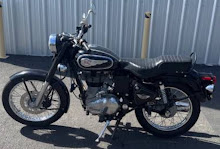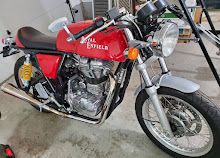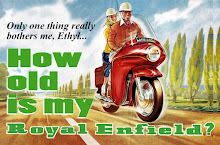 |
| The proud factory of Royal Enfield in Redditch, Britain. |
Author Anne Bradford's outstanding 1996 book "Royal Enfield, The Story of the Company and the People Who Made It Great: 1851-1969" is largely a collection of contributions from people who worked at the Royal Enfield factories in Redditch, England before the firm went out of business there.
The interviews, edited by Ray Knight, are precious and revealing; but that is not all there is, the book explains:
"In order to produce a book at reasonable cost, Ray Knight has had to carry out some vigorous editing. A copy of all interviews in their entirety have been lodged at the Redditch Library and in the archives of the Royal Enfield Owners Club."
In these archives we learn what had to be left out. In all, editor Ray Knight did a fine job of keeping contributors on subject. But some of the left-out material is eye opening.
You should read the book to know the full story of Royal Enfield in Redditch. But, below, I'll offer some bits that were trimmed out in hope that these small additions broaden the story for you.
At 16, Redditch lad Vic Bott and some pals abandoned their protected factory apprenticeships to enlist for World War I. He served in the trenches of the Western Front from 1916 to 1918 in "wet, mud and desolation."
When peace came, in 1918, it found the young men with "no jobs and no skills and we were thrown into a mass of (now unemployed) munition workers whose generous pay and skill created a 'them and us' situation."
As a result, "the 1920s, were vicious," Bott said.
Royal Enfield took on as many former soldiers as it could, including a grateful Bott, but this inevitably meant lay-offs for everyone when business was slow.
"In the whole history of the factory, the worst trouble came during the 1926 General Strike..."
"Out of a workforce of about 260, 90 to 100 people refused to strike and most of these were ex-servicemen. When we walked into work we had to go through a crowd of pickets on the gate, all booing and shouting and calling us 'blacklegs.'* This caused a lot of bitterness on both sides, which continued for many years and sometimes marred an otherwise happy and friendly atmosphere."
The British Legion, a charity for former soldiers, helped. Bott proudly states that, in Redditch, it did so under the leaderships of the father and sons who managed Royal Enfield.
Royal Enfield managing director R.W. Smith provided a lodge for meetings. Son Frank Walker "Major" Smith was president of the British Legion in Redditch. Major's younger brother Gilbert was treasurer, and the youngest, Stanley, was chairman.
There were better times to come.
Bott remembers assembly and testing departments supervisor Fred Bicknell, who was so esteemed they called him "Mr. Royal Enfield." He competed in trial events, contributing to the brand's reputation.
Bicknell returned from one event where he had spent too long having to change a rear wheel. He devised the clever split rear fender that gets out of the way of removing the rear wheel by loosening only two nuts. You don't even have to entirely remove the two nuts!
 |
| Clever swinging rear fender eases access to rear wheel. |
Ray Knight edited this out of the book (probably rather than have to explain how the fender works) but now I know to thank Fred Bicknell every time the design eases maintenance of my 1999 Royal Enfield Bullet!
A high proportion of women were workers in Redditch factories, Bott said. The firms had started as light industry -- making needles and fish hooks -- so there was a local tradition of women on the shop floors.
He claims that at Royal Enfield the women factory workers in overalls earned more than the better dressed women in the offices, who had shorter hours and more comfortable conditions.
Bott is a fountain of information, all of it fascinating, and much of which had to be left out of the book. He talks about how hard it was to work at a piece work rate, where a difficult job done carefully might pay less than an easy one done quickly.
Work started at 8 a.m. and you had better not be late; they locked the gate and docked your pay.
There was an unofficial tea break at 10 in the morning and lunch was noon-1 p.m. When, around 1922, the factory got a tin shed as a lunch room, factory workers and staff sat in separate areas -- not because of social distinctions, but only because the factory workers' clothes were typically greasy.
The then new factory was in the countryside; you could go for a stroll, or play soccer, cricket or tennis on a field provided for workers (today a company would certainly utilize that space for a parking lot, I suppose).
There was no afternoon break. Work ended at 5:30, but you'd stay for overtime if you were allowed.
Bott is quoted as saying that Royal Enfield made its own sidecars in those days, out of "American" white wood. In the book this is changed to "Armenian" white wood. I'd guess the archival version may be more accurate than the published version in this one case.
As always in memoirs, it's important to keep in mind that some memories from long ago may be inaccurate or were hearsay to start. While most trims were made to save space in the book, some archived cuts might also have been made because the information could not be confirmed.
We'll look at more deleted gems in my next blog item.
*Various sources explain that "blacklegs" was not a racial term. It's used in the same sense "scabs" is used in the United States. One origin suggested is that men who meant to disguise that they were working with coal would roll up their pant legs to keep them clean, but the coal-black skin of their legs would give them away.































No comments:
Post a Comment